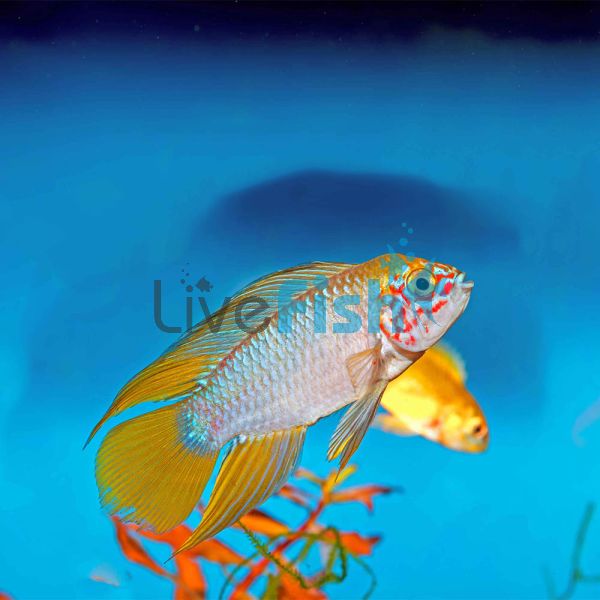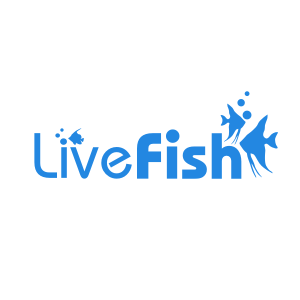Apistogramma Borelli 2.5cm
The Apistogramma Borelli is a great dwarf cichlid that truly shines in its simplicity when compared to others of its species Apistogramma. The Borelli has a beautiful light cream base colour which develops into a powder blue. This shining powder blue colour also earns them the name Borelli ‘opal’ or the dwarf opal cichlid as they truly look like a gem. They also have a deep gold colour on their head and fins with their most striking factor being the script-like patterning of blood red on their face.
Apistogramma Borelli
The Apistogramma Borelli is a great dwarf cichlid that truly shines in its simplicity when compared to others of its species Apistogramma. The Borelli has a beautiful light cream base colour which develops into a powder blue. This shining powder blue colour also earns them the name Borelli ‘opal’ or the dwarf opal cichlid as they truly look like a gem. They also have a deep gold colour on their head and fins with their most striking factor being the script-like patterning of blood red on their face.
These fish are natural like this and unlike certain Apistogramma species have not been selectively bred for their colours. They are a great fish to try out for aquarists looking to enter the dwarf cichlid world and are a fantastic alternative to some of the more sensitized dwarf cichlids like blue rams. This fish would be a great long-term addition to a display community aquarium or a South American biotope and would be a real eye-catcher to look at.
Trying to find the males and females in this species is possible where adult males have bolder colours and more bright blue scales whereas females have paler bodies. This form of Apistogramma is not an extremely shy species and will readily present its personality to its owners. Because of the fact they are tank bred and not wild-caught they adapt far easier to a change in aquarium conditions. This dwarf cichlid would do best with other small community fish such as gouramis, tetras, and corydoras. naturally, the wild Apistogramma Borelli habitat in South America.
Tank Recommendations for your Apistogramma Borelli
The Apistogramma Borelli only needs a tank of around 20 gallons (75 liters) as they are small growing fish. This makes them great for smaller community aquariums or to just show off a breeding pair of Borelli’s. A sand substrate is advisable as these cichlids actively will sift through the sand looking for food. They will also appreciate hiding areas around small pieces of driftwood, and rock caves and they will love a densely planted aquarium as well which can really assist when looking to breed these fish, This species is most active during the day when the lights are on.
Suitable Tank Buddies
The Apistogramma Borelli is quite peaceful with mild aggression only ever coming out during breeding. With adequate space, these fish will get along with a wide range of community fish.
Usually Compatible
Tetras, gouramis, corydoras, angelfish, cherry barbs, and common community fish species.
Sometime Compatible
Other Apistogramma species and dwarf cichlids such as rams and large peaceful cichlids such as uaru or Severums might outcompete for food.
Rarely Compatible
Shrimp and large aggressive species such as African cichlids, Oscars, and Jaguar cichlids.
Feeding your Apistogramma Borelli
Being tank bred the Borelli will easily consume aquarium foods. Naturally, they are carnivores and they will readily prefer meaty foods. They will consume a wide range of dry and frozen foods. Their diet should contain good quality sinking pellets or flakes and be supplemented with frozen food that has high protein such as bloodworm, brine shrimp, and daphnia. Feeding should occur once a day and it is best to do so when the lights are on during the day.
| Scientific Name | Apistogramma sp. |
|---|---|
| Care Level | Moderate |
| Common Names | Apistogramma Borelli, Borelli ‘ opal’ |
| Diet | Carnivore |
| Fish Family | Cichlidae |
| Lifespan (years) | 10 |
| Max. Length (cm) | 7 |
| Min. Tank Volume (l) | 75 Litres |
| Origin | South America |
| Sociability | Peaceful |
| Venomous | No |
| Water Conditions | 24-26° C, pH 5.0-7.0 |



